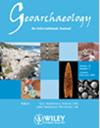朝鲜半岛中部旧石器时代遗址发生与过去气候变化之间的可能联系
IF 1.4
3区 地球科学
0 ARCHAEOLOGY
引用次数: 0
摘要
韩国的旧石器时代遗址主要位于河流环境和冲积扇的边缘。在朝鲜半岛进行了100多个旧石器时代的挖掘,但这些遗址的位置与过去气候变化之间的关系很少受到关注。在这项研究中,我们在韩国原州市的旧石器时代遗址调查了这种关系,该遗址包含两个文化层,共出土了336件石器制品。现场的岩性单元表明,在海洋同位素阶段(MIS) 4,由于河道迁移,沉积环境由河流砂质河道转变为冲积平原。MIS 4-2期间沉积的冲积平原沉积物具有含沙量低(<5%)和两个土楔的特征。大多数旧石器时代的文物是从上部土壤楔中挖掘出来的,在MIS 3期间沉积在相对温暖和潮湿的条件下,与全球气候变化(由海平面或大陆冰量表明)和东亚夏季季风有关。在其他地区,旧石器时代文化层的数量在MIS 3晚期有所增加,表明气候条件是旧石器时代文化层发展的重要因素。本文章由计算机程序翻译,如有差异,请以英文原文为准。
Possible linkage between Paleolithic site occurrence and past climate change in the central Korean Peninsula
Korea's Paleolithic sites are primarily located in riverine environments and the margins of alluvial fans. More than 100 Paleolithic excavations have been conducted in the Korean Peninsula, but the relationship between the locations of these sites and past climate change has received little attention. In this study, we investigated this relationship at a Paleolithic site in Wonju city, Korea, that contained two cultural layers and yielded a total of 336 stone artifacts. The lithological units present at the site indicate that the sedimentary environment changed from a riverine sandy channel to an alluvial plain owing to channel migration at the Marine Isotope Stage (MIS) 4. The alluvial plain sediments deposited during MIS 4–2 are characterized by low sand content (<5%) and two soil wedges. Most Paleolithic artifacts were excavated from the upper soil wedge, deposited during MIS 3 under relatively warm and wet conditions associated with global climatic changes (as indicated by sea level or continental ice volume) and the East Asian summer monsoon. The number of Paleolithic cultural layers increases in late MIS 3 in other regions, suggesting that climate conditions are an essential factor in the development of Paleolithic cultural layers.
求助全文
通过发布文献求助,成功后即可免费获取论文全文。
去求助
来源期刊

Geoarchaeology-An International Journal
地学-地球科学综合
CiteScore
3.60
自引率
5.90%
发文量
51
审稿时长
>12 weeks
期刊介绍:
Geoarchaeology is an interdisciplinary journal published six times per year (in January, March, May, July, September and November). It presents the results of original research at the methodological and theoretical interface between archaeology and the geosciences and includes within its scope: interdisciplinary work focusing on understanding archaeological sites, their environmental context, and particularly site formation processes and how the analysis of sedimentary records can enhance our understanding of human activity in Quaternary environments. Manuscripts should examine the interrelationship between archaeology and the various disciplines within Quaternary science and the Earth Sciences more generally, including, for example: geology, geography, geomorphology, pedology, climatology, oceanography, geochemistry, geochronology, and geophysics. We also welcome papers that deal with the biological record of past human activity through the analysis of faunal and botanical remains and palaeoecological reconstructions that shed light on past human-environment interactions. The journal also welcomes manuscripts concerning the examination and geological context of human fossil remains as well as papers that employ analytical techniques to advance understanding of the composition and origin or material culture such as, for example, ceramics, metals, lithics, building stones, plasters, and cements. Such composition and provenance studies should be strongly grounded in their geological context through, for example, the systematic analysis of potential source materials.
 求助内容:
求助内容: 应助结果提醒方式:
应助结果提醒方式:


